Menu
You can manage your membership and billing method by clicking here
Terms of Service
Privacy Policy
Copyright © 2025 Office of Immigration Australia, a private company registered in Australia. All Rights Reserved.

Checking membership status...
 EXCLUSIVE MEMBERS ONLY ACCESS
EXCLUSIVE MEMBERS ONLY ACCESSTo access this month’s edition & Member’s only resources, enter your registered email address.



Exclusive Australian Immigration News, Updates & Opportunities
August 2023
This bulletin is for members only, and provides our members with month to month updates on Australian immigration policy changes and consequential opportunities. Opportunities are found via federal and state government policy shifts for the demand and supply for certain occupations.
This bulletin will keep you up to date so that you do not have to employ expensive immigration lawyers to provide you with monthly research.
August 2023 has landed and Australia is now one of the ‘biggest migrant nations’ on earth, with a new study showing that Australia now has the highest per capita proportion of migrants in the western world!
This announcement is great news as Australia continues in the global fight to attract international talent and plug the growing number of skill shortages!
With Australia now breaking immigration all-time record highs, 2023 is proving to be one of the most significant years in Australian immigration history!
In this month’s ‘Federal News‘, new data from the Regional Australia Institute shows migration to be the lifeblood of many regional communities as overseas residents continue to prop-up local population numbers and contribute in providing crucial local services!
Also in this month’s federal news, we go over a general introduction to immigration law and policy in 2023 Australia.
In this month’s ‘State News’, skilled workers residing offshore remain eligible to be considered for ALL State and Territory nominations! Please view the State Migration Section of this month’s bulletin for all State and Territory program updates and opportunities available!
In this month’s ‘Economic News’, new data shows that Australia gained a record new 497,756 migrants in 2022 as immigration surged! The extra half a million people who called Australia home in 2022 will underpin economic growth and ease some of the tight job markets. In an era though of falling natural population growth, Australia will continue to need a greater number of highly skilled migrants in order to turbocharge the economy.
Also in this month’s economic news, we take a closer look at the unique riverside city of Hobart, as Hobart has just been crowned the best city in Australia, New Zealand and the South Pacific to visit!
In this month’s ‘Student News’, the much-awaited, ‘extended two-year visa stay’ is now available for eligible international Temporary Graduate visa holders. The Australian government recently released the list of over 3,200 courses which are all eligible for the free ‘485 visa’ extension, and in this month’s ‘Student News’ we show you how to apply.
All this and much more in the August issue of The Australian Immigration Bulletin! Let’s take a deeper look at what has happened so far and what is planned for the remainder of August 2023 in Australian Immigration, so that you can start planning!
In case you missed it…
We are excited to announce a new benefit now available which allows all our member’s FREE access to an online platform and course to practice, study and improve their English and IELTS score. The IELTS exam is one of the key recommended exams you will need to take in order to Apply for Skilled Migration to Australia and the better your results, the higher points you will get when submitting an expression of interest. The advanced English and IELTS platform will allow all members to practice Mock IELTS Exams, learn cutting edge tips and gain a greater understanding of how to achieve a Band 9+.
We are also excited to announce “ImmiConnect” which is now available in the member’s area. ImmiConnect is the Office of Immigration Australia’s Employer Sponsored program which allows overseas workers to receive job interview invitations from Australian employers, when job opportunities come available.
The program aims to bring globally mobile, highly-skilled and specialised individuals to Australia who can fill critical areas of need.
ImmiConnect is exclusive to active Australian Immigration Bulletin Members only. You must be a current Australian Immigration Bulletin Member to be eligible to receive job interview invitations.
So if you are interested in receiving these invitations, please sign up for FREE by Clicking “ImmiConnect” and adding your name and email address.

*2 WINNERS DRAWN every month. May 2023 – September 2023. (10 winners/prizes in total)
There is always a winner, and the next one could be you!
The winners of the August 2023 Immigration Prize Giveaway were drawn at 10am AEST on 1st August 2023.
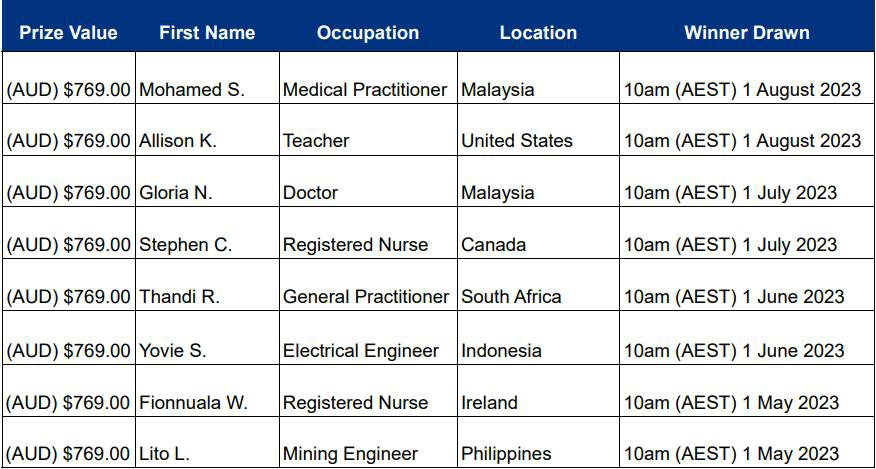
Congratulations to the August 2023 winners! You have been sent a confirmation email with details on how to claim your prize!
The next 2 lucky winners will be drawn at 10am AEST on 1st September 2023.
As of 6th July 2022, people entering Australia do NOT need to provide evidence of Covid-19 vaccination status. Additionally, people leaving Australia will NOT be asked to provide evidence of their vaccination status. Unvaccinated visa holders do NOT need a travel exemption to travel to Australia. It is however important to remember that airlines, vessel operators and other countries may have specific requirements that travellers need to comply with.
Please see the list of vaccines that are recognised by the Australian government for travel purposes here.
This Bulletin and its contents is for general information purposes only and should not be used as a substitute for consultation with professional advisors.
As legislation and travel requirements are constantly changing, we strongly recommend obtaining advice on your individual situation from a Registered Migration Agent.
Please click here to book a consultation with one of our Registered Australian Migration Agents, located in Australia.

Hobart, Tasmania
The Results of the August 2021 census were made public on 12th July 2022, and revealed that Australia has become a majority migrant nation, as the census data shows for the first time that more than 50 per cent of residents were born overseas or have an immigrant parent. Last year’s census counted nearly 25.5 million people, including 1 million new residents.
Australia’s 2022-23 Migration Program has been carefully designed to boost the social and economic outcomes that meet Australia’s needs. In fact, the migration programme was first launched in 1945 following the aftermath of World War 2. Given this long history, it is worth understanding how it works. The Australian Immigration Bulletin exists to help explain this in more detail.
As we’ve entered the 8th month of the year, join us for a look at the latest news and developments in the world of Australian Immigration!

We spoke with Juliana, a skilled migrant who is an architect graduate from Brazil currently living and working for a private company in Australia.
Tell us about your work
I have a passion for minimalist and tiny house movements as alternative expressions of sustainable lifestyles. I have been in Australia for 4 years now and loving it. I got my first job in architecture in Australia in January this year and I have been there for 7 months now. It is a small practice with 6 professionals sharing a common space. I work very closely with the director, a senior architect, and the other 3 graduate architects, and everyone is very experienced and supportive.
We do a lot of projects for public and private schools, housing projects, and also a few clinics and residence renovations.
What was the biggest challenge and how did you deal with it?
Communication is probably the biggest challenge for me. You have that huge responsibility for what you’re doing, so you have to make sure all information you get is correct, express your ideas clearly, and speak up when necessary.
So, every time I have to speak on the phone with builders, consultants, council, and representatives, or go to meetings, I try to prepare myself and take some notes to make sure I know what to say and how to express my ideas.
I have also been trying to read more texts in English and listen to podcasts related to architecture to improve my vocabulary. Grammarly is also a great app to help with writing emails and documents.
How did you find out about it?
I was working in a café for one year and there I got the chance to meet many locals. So after a while, I started mentioning my background in casual conversations with regular customers.
I think networking is very important especially in Australia. So, I would recommend someone looking for a job in Australia to visit your industry’s institute, tell them your story and ask to receive their newsletter. They are very supportive and may inform you about some good opportunities.
Another idea is to keep an eye on the events organized by your industry as they are a great opportunity to meet people and get involved in your local industry community.
How did you apply?
One of the interviews I went was for an Engineers and Planner’s office. The interview was great but both parties understood I wasn’t a good fit because my main interest and experience was Architecture rather than Urban Planning. So, I didn’t get the job, but after a few weeks, they referred me to my boss who was looking for a graduate architect at that time.
How did you convince them you had the skills to do the job?
I think it was a good idea to print my portfolio and to take it with me to my interview to support my speech. The portfolio helped me when speaking about the projects I’ve done in the past, to show my abilities in design and architectural representation, and what I could do with the software I use. Even if you have already sent the portfolio by email, I think most people are too busy to look at them carefully enough and it pays off to bring a copy with you and leave it with them at the end of the interview.
I believe it also helped me to study the business I was applying to, understand their projects, and demonstrate proactivity and enthusiasm to learn.
What have you learned from this job that you will take to your next job?
This is still my first job here in Australia, and I am learning new things each day. But in the future when I feel it is time to move on for something new, I hope I’ll take with me a much better understanding of the local industry: the construction methods, local suppliers and materials, the Australian Standards for drafting and documentation, and also some knowledge on Contract Administration.
What did you learn about yourself doing this job?
It may sound a bit cliché, but I learned that I am capable to do absolutely anything. What we don’t know, we can learn with time and patience, we just need the motivation.
So, I feel I’ve been improving my confidence in myself every day. Because we come from another country, sometimes we tend to think we are not good enough, or that have to wait until our English is perfect, or until we study this or that software. But I believe that businesses are also interested in motivated and creative professionals with the ability to adapt and that’s where we stand out.
What tip would you give job seekers from other backgrounds eager to get their first job in Australia?
I would say that networking is a must in Australia. Go to as many events as you can, and get involved with the local community in your industry. Talk to people, listen to them and show you are interested.
Also, make sure you have a good portfolio or CV that expresses the knowledge you have, and remember to ask someone to proof read it. Show enthusiasm and motivation to learn.
It is sometimes hard when you are looking for your first job in your area because you may get a few no’s before you have a yes. But you only need your first ‘yes’, so be patient with yourself throughout that process. We already have the determination to start all over again, so know that the experience and knowledge we bring with us are valuable and unique.

Australia’s immigration programme is a non-discriminatory programme open to anyone who meets the desired visa criteria as set out in Australian law. Australia’s immigration policy is structured to effectively respond to Australia’s economic, democratic, humanitarian and social interests. It is aimed at ensuring that migration is beneficial for the current and future economic and social growth of Australia.
It has become even more important to promote Australia’s economic recovery since the coronavirus pandemic. As a result, there is a growing emphasis on skilled migration targeting migrants with specific skills and abilities that support sectors in demand following the pandemic, that meet the needs of the local labour market, that alleviate the impact of an ageing population and that promote income tax revenue.
Australia’s recovery from the onset effects of the covid-19 pandemic sees the Australian immigration framework evolving and embracing migrants with an unprecedented importance and catering for skilled migration. For example, the introduction of new programmes and streams, the implementation of a global talent attraction scheme, the revolutionary merging of different visa subclasses and streams, an incremental allocation of places in certain visa categories, and conspicuous efforts to promote regional development and population growth.
The global pandemic has also posed a previously unseen challenge to immigration in the unprecedented action of the closing of international borders. However, 2022 and 2023 have brought about a recovery for the harshly impacted immigration sector.
With a new government led by Prime Minister Anthony Albanese, Minister for Home Affairs the Hon Clare O’Neil MP and Minister for Immigration, Citizenship and Multicultural Affairs the Hon Andrew Giles MP have taken steps towards evaluating and improving the immigration processes in Australia. Members of Parliament, union figures and council officials, among others, have come together to work constructively on the issues and opportunities facing the Australian labour market and economy in the wake of the recovery of the global economies post covid-19.
States and countries alike have turned to an imminent focus on foreign talent and skilled workers to rebuild their economy and restrengthen the damage caused by border closures and isolation orders on the workforce and key industries.

Ever since Australia’s first immigration minister Arthur Calwell urged the nation to “populate or perish” after World War II, migration has been a core part of Australia’s society, economy and identity.
Today, more than half of all living Australians or their parents were born overseas.
Australia, one of the most desirable locations in the world, aims to attract highly skilled migrants in the global race for talent, according to a government-commissioned review led by former top bureaucrat Martin Parkinson.
Temporary migrants living in Australia have also doubled to more than 2 million people over the last 15 years, who have in effect become “permanent”.
Parkinson says a targeted migration program helps improve the nation’s dwindling productivity, enhance human capital, lift business competitiveness and mitigate the fiscal costs of an ageing domestic population.
Australia can no longer keep relying on increasing the labour force participation of domestic females, which is already around a record high.
“We’ve got an economy that can’t be supported by the size of the permanent population,” Parkinson says.
“It’s clear that we are being left behind by our global competitors.”
In past decades, the United States, Canada and the United Kingdom were the major competitor destinations for skilled migrants. Today, Germany, Russia, Israel and Spain are among the top 10 destinations for skilled workers.
Australia’s global share of skilled migrants has slipped from third in the 1990s to sixth in 2020, or from 7 per cent to 4 per cent. Ageing populations and declining birth rates are challenging the demographic profiles of many major economies. There is a war for talent.

Regional Australia Institute chief economist Kim Houghton recently said migration plays a pivotal role for regional communities.
Data from the institute shows issues with maintaining population in the regions, with some areas being propped-up by overseas populations.
“One of the reasons why it is so important is there is a general trend of population decline in regional areas. Slow, slow, population decline,” Dr Houghton said.
“But we find [some] local government areas where their overseas population numbers are going up, according to census data, even when Australian-born populations are going down.”
“For those places, those overseas residents are their lifeblood.”

Study shows Australia leads most of the world in per capita migrant population
Australia has always been a high migration nation, but new figures show we are world-beaters at welcoming people looking to start a new life.
Australia has the highest proportion of migrants in the western world, well above similar countries like the US and Canada, a data analysis shows.
As debate rages over upcoming record net migrant intakes, Australia’s position as a 30 per cent migrant nation is set to go even higher. (More than 50 per cent of Australian residents were born overseas or have an immigrant parent)
Canada, which is a similar high immigrant country, is only 21.2 per cent migrant, while the US has 15.3 per cent of its residents born overseas, according to a review of global migration data.
Migrant populations in other western nations include Germany (18.8 per cent), Spain (14.5 per cent), UK (13.8 per cent) and France (13 per cent).
Countries with extremely high migrant cohorts are those with massive numbers of overseas workers such as UAE (88 per cent) and Qatar (77 per cent).
Net overseas migration for Australia is tipped to reach 400,000 in 2022-23, far higher than the pre-Covid trend of about 235,000.

Australia needs much more highly skilled migrants in an era of falling natural population growth.
“Migration, particularly skilled migration, has increased the size of the working age population and the level of labour force participation, as well as slowing the economic and social effects of population ageing.”
An OECD forecast has stated that Australia’s population median age will rise from 37.3 to 38.6 by 2050. This compares favourably with the bulk of OECD countries where the median age is expected to be 45 or more by 2050.
Treasury research now shows skilled young migrants are the biggest individual contributors to national wealth, far exceeding other entrant categories including employer-sponsored migration, and outstripping the “lifetime per person economic contribution” of Australians born in Australia by $3.6 million to $1.6 million.

If you are interested in applying for a general skilled migration visa to Australia, it is important to have a good understanding of the skilled visa options and how the migration points test works, so that you can maximize your chances of being eligible to apply for a skilled visa.
A general skilled migration visa is an option available to skilled workers who are seeking to qualify for a skilled visa independently, or under a state or family sponsorship. It is an alternative to an employer sponsored visa.
One of the key criteria to qualify for a general skilled migration visa is the points test (a criterion that does not apply to employer sponsored visas). This is often the most challenging aspect for prospective skilled visa applicants to overcome when seeking an invitation to apply for the relevant skilled visa.
If you are considering applying for a general skilled migration program visa, an important concept to understand is the Expression Of Interest (EOI).
If you are considering applying for a general skilled migration visa, it is important to be aware that for certain visas in this visa class, you will first be required to lodge an EOI with the Department of Home Affairs (the Department) through Skill Select. The EOI is not a visa application, but rather, it is the process by which you can express your interest in applying for the relevant skilled visa (It’s important to note, that there is NO fee to submit an EOI).
This requirement applies to the following skilled visa subclasses:
Let’s take a brief look at each of these visas below:
The ‘subclass 189’ is a federal sponsored visa that grants automatic permanent residence in Australia. It is subject to nil visa conditions or obligations. For this reason, it is often considered to be the most flexible of the skilled visa options available.
A subclass 189 points-based visa allows you to live and work in any state or territory permanently.
The ‘subclass 190’ is a state/ territory sponsored permanent residence visa. It is another points-based visa for which invitations are issued throughout each month by individual states and territories. One of the benefits of applying for state nomination is that you will be granted an additional 5 points.
An important aspect to consider, which does not apply to the subclass 189 visa is that there is an added step in the application process. In this case, you must also apply for nomination approval to a state or territory government. Only upon receipt of an invitation from the relevant state or territory to which you apply can you then apply to the Department for the visa itself.
Your obligations as a subclass 190 visa holder are that you must commit to your nominating jurisdiction’s obligations and commit to residing in your nominating State or Territory for two years from visa grant.
The ‘subclass 491’ is also a points-based state/ territory (or family) sponsored visa. It is a regional visa with a term of five years. The Department issues invitations for family sponsored EOI applications only (in invitation rounds). Invitations for state sponsorship are issued by individual states and territories throughout each month. This will grant you an additional 15 points for the nomination.
Being a provisional visa, this means it provides a pathway to permanent residence in Australia with the Subclass 191 Permanent Residence (Skilled Regional) visa, subject to meeting specified requirements.
Be mindful that as a subclass 491 visa holder, you must abide by visa condition 8579, which requires you to live, work and study in a designated regional area of Australia. For migration purposes, most locations of Australia outside of major cities (Sydney, Melbourne, Brisbane, Perth, etc.) are classed as regional areas.
If your EOI is successful, you will receive an invitation to apply for the visa, as specified in the invitation letter. This then enables you to proceed with lodgment of your visa application (provided you meet all other visa lodgment and visa grant requirements).
Please note, the below State and Territory program updates is a general overview only. It does not take into account any of your personal circumstances. You must check the State/Territory information carefully to ensure you can meet all the requirements for nomination.
Australia is currently facing a shortage of skilled migrants to fill workforce demands. In response, states and territories have been easing the conditions of their visa programs to help attract skilled workers from overseas.
Below is the monthly update for some of the State and Territory opportunities available.

Program Status Update
People residing offshore are now eligible to be considered for Northern Territory (NT) nomination. Invitations to apply for Northern Territory nomination will be via the ranking system.
The ‘Northern Territory Offshore Migration Occupation List’ identifies the occupations in current demand in the Northern Territory. This List is important if you want to apply for Northern Territory nomination for either a:
The ‘Northern Territory Offshore Migration Occupation List’ is only applicable for those applying for NT nomination from outside Australia, under the Priority Occupation stream.
Please note: The Northern Territory government has advised that offshore applicants will generally only be offered a Northern Territory nomination for a subclass 491 visa. Subclass 190 nominations will only be offered in exceptional circumstances, such as cases where the applicant has strong connections to the NT.
The NT advises eligible applicants to apply as soon as they meet the eligibility criteria. To receive a nomination from the NT Government, you must:
Before submitting an EOI for The Northern Territory, applicants should check that they meet all eligibility requirements.
For a further explanation, see the Frequently Asked Questions page on the Northern Territory Government website.

Program Status Update
To manage Queensland’s COVID recovery response, applicants currently residing offshore are now able to apply.
Depending on your occupation and situation, there are two state nomination options available for skilled migrants through Queensland.
For Queensland state nomination, prospective applicants must meet the Department of Home Affairs requirements, state-specific occupation requirements and have skills in an occupation that is available on the Queensland Skilled Occupation List.
You may undertake employment once onshore in Queensland through:
Offshore applicants meeting the minimum published requirements can now lodge an Expression of Interest (EOI).
Migration Queensland criteria requires you to:
The agency also requests all applicants to ensure they have carefully read and understood the new criteria relevant to their stream or pathway, and that they meet the criteria before submitting an Expression of Interest (EOI).
The 2022-23 Skilled Migration Program will be open to both onshore and offshore applicants and provide pathways for skilled workers, graduates, and small business owners.
Before submitting an EOI for Queensland, applicants should check that they meet all eligibility requirements.
For a further explanation, see the Frequently Asked Questions page on the Queensland Government website.

Program Status Update
Open to offshore applicants, the program provides skilled migrants with a pathway to permanent residency in Victoria. The skills that successful applicants bring to Victoria benefits employers and the broader Victorian economy.
The program provides two visa pathways.
The Skilled Nominated visa (subclass 190) is a permanent visa for skilled migrants to live and work anywhere in Victoria. The Skilled Work Regional (Provisional) visa (subclass 491) is for skilled migrants to live and work in regional Victoria and provides a pathway to permanent residency through the Permanent Residence (Skilled Regional) visa (subclass 191).
As with previous years, applicants will first need to submit a Registration of Interest (ROI) and then be selected on competitive merit to apply for visa nomination.
Both onshore and offshore applicants are eligible to submit a Registration of Interest (ROI) for both the subclass 190 and subclass 491 visas.
This is a significant change from the 2021-22 Skilled Migration Program, which did not allow applications from individuals overseas. Additionally, the new program is a great opportunity for applicants who work in a variety of occupations, particularly since the 2021-22 program was previously aimed at applicants in science, technology, engineering, mathematics and medicine (STEMM).
If you submitted a ROI during the 2021-22 program, you must submit a new ROI to be selected to apply for the 2022-23 program.
Your ROI will remain in the system for selection until it is withdrawn, selected or the program year ends.
Before submitting an ROI for Victoria, applicants should check that they meet all eligibility requirements.
For a further explanation, see the Frequently Asked Questions page on the Victoria Government website.

Program Status Update
People residing offshore are now eligible to be considered for Western Australia (WA) State nomination. Invitations to apply for WA State nomination will be via the ranking system.
The Western Australian Skilled Migration Occupation List identifies the occupations in current demand in Western Australia. This List is important if you want to apply for Western Australia nomination for either a:
Please note that to be eligible for an invitation in the WA State Nominated Migration Program, you must meet both:
Before starting your application, you will need to check whether your occupation is available on either the WA Skilled migration occupation list (WASMOL) Schedule 1 or 2, or the Graduate occupation list. You can search for your occupation here. (The occupation list search bar is located under the heading ‘Eligible Occupations’.)
For the 2022-2023 program, the WA Government is temporarily waiving the $200 application fee. Additionally, applicants who apply after this date will no longer need to provide proof of sufficient funds for WA State nomination.
Under the Western Australia Skilled Migration Program 2022-23, the English language requirement has also been reduced for applicants at the Manager and Professional occupation level. Applicants at this level will only need to demonstrate a “competent” proficiency in English (which is a minimum ‘IELTS score of 6’ for each of the 4 categories).
Before submitting an EOI for Western Australia, applicants should check that they meet all eligibility requirements.
For a further explanation, see the Frequently Asked Questions page on the Western Australia Government website.

Program Status Update
The ACT Critical Skills List identifies the occupations in current demand in the ACT. This List is important if you want to apply for ACT nomination for either a:
The ACT Government will update this list every four months to make sure that the ACT Skilled Migration Program adapts and responds to the evolving critical skills needs of the ACT economy.
The Canberra Matrix is weighted to ensure that applicants who will make a positive economic contribution to the Territory and/or have demonstrated a genuine commitment to the ACT are more likely to be ranked and invited to apply for ACT nomination.
*ACT nomination does not guarantee a migration outcome. You must still meet the Department of Home Affairs criteria.
Every month, a certain number of nomination invitations are available (prorated on the annual allocation) to those working in the highest ranked Matrix in each occupation.
You can view the ACT’s most in-demand skills for skilled migration by consulting the ACT Critical Skills List.
Before submitting an EOI for The Australian Capital Territory, applicants should check that they meet all eligibility requirements.
Once you’ve submitted a valid Department of Home Affairs Skill Select EOI, follow the ACT Government Process to apply for ACT nomination.
For a further explanation, see the Resources page on the ACT Government website.

Program Status Update
To manage South Australia’s COVID recovery response, applicants currently residing offshore are able to apply.
Depending on your occupation and situation, there are two state nomination options available for skilled migrants through South Australia.
For South Australian state nomination, prospective applicants must meet the Department of Home Affairs requirements, state-specific occupation requirements and have skills in an occupation that is available on the South Australian Skilled Occupation List. Offshore applicants meeting the minimum published requirements can now lodge an Expression of Interest (EOI).
There is an enormous range of occupations on South Australia’s Skilled Migration Occupation List in a range of industries – search for your occupation here.
South Australia will increase its nominations of offshore skilled migrants in 2022-23. This is in order to make entry to the South Australian labor market faster, due to urgent skills shortages.
To do this, South Australia will select offshore applicants to apply for state nomination from those who have submitted an Expression of Interest (EOI) through Skill Select. Offshore applicants will not need to lodge a Registration of Interest (ROI) for this year’s program. South Australia will be nominating offshore applicants from over 470 occupations on South Australia’s Skilled Migration Occupation List. To be eligible, ensure all the information in your Skill Select EOI is up to date and you have selected South Australia as your first preferred state or territory to move to in Australia.
South Australia will be assessing candidates on merit by the following factors, within their nominated occupation:
Before submitting an EOI for South Australia, applicants should check that they meet all eligibility requirements.
For a further explanation, see the Frequently Asked Questions page on the South Australia Government website.

Program Status Update
Working in Tasmania
The two state nomination options available for skilled migrants through Tasmania are:
The Tasmanian State Nomination Skilled Migration Program supports Tasmanian businesses and increases the state’s working age population. It does this by attracting and retaining migrants with skills genuinely in need by employers, or with the capacity to settle in Tasmania through skilled employment in the long-term, and business activities that will increase employment opportunities.
Tasmania’s skilled migration program is for people wanting to move to the state who have skills that Tasmania need. Skilled migrants are attracted to Tasmania because of the state’s enviable lifestyle, career opportunities, affordable housing, reputable schools and a globally recognized university.
The new Migration Tasmania Application Gateway is now available for registrations of interest (ROI) and applications for skilled visa nomination from Tasmania.
Anyone seeking Tasmanian nomination for a Subclass 190 Skilled Nominated Visa or Subclass 491 Skilled Work Regional Visa must first register in the Migration Tasmania Application Gateway .
Before submitting an ROI for Tasmania, applicants should check that they meet all eligibility requirements for either;
ROIs submitted before 1 July 2023 will remain valid for the 2023-24 program year.
ROIs and applications submitted from 5 July 2023 fall under the new eligibility requirements.
In cases where new requirements are likely to be beneficial, candidates may wish to withdraw their current ROI and submit a new one. (There is no charge to submit a Registration of Interest)
For a further explanation, see the Frequently Asked Questions page on the Tasmania Government website.
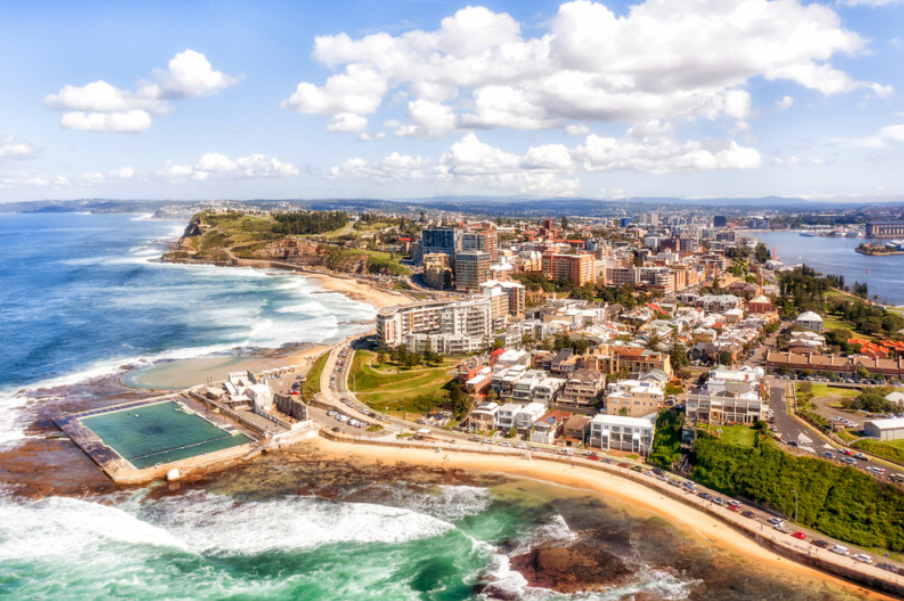
Program Status Update
The New South Wales government has invited applications from offshore migrants under the following nomination streams:
The NSW State Government announced that offshore applicants skilled in certain ANZSCO unit groups are still eligible for NSW nomination.
*Please note: Invitation rounds occur frequently throughout the financial year with no set date.
NSW invites and nominates Skill Select EOIs at the ANZSCO unit group level. To be eligible for NSW nomination (for either Subclass 190 or Subclass 491) you must be skilled in an occupation that both:
It is important to note that not all occupations within ANZSCO unit groups are eligible for the respective visa. It is the responsibility of the prospective migrant to ensure their occupation is eligible for the visa before obtaining a skills assessment.
For the 2022-23 financial year, NSW have introduced a new requirement regarding your Skill select EOI. To be eligible for NSW nomination, your Skillselect EOI must be for ONE visa and for NSW only.
This means that if your Skill select EOI has multiple visas and/or multiple states selected (this includes selecting ‘ANY’), your Skill select EOI will not be considered for NSW nomination.
The skills lists for 2022-23 are available on the Investment NSW website. Additional ANZSCO unit groups will not be added this financial year, however, the skills lists are reviewed annually.
Before submitting an EOI for New South Wales, applicants should check that they meet all eligibility requirements for either;
For a further explanation of how the skills list works, see the Common questions about skilled visas page on the NSW Government website.

Australia gained a record new 497,756 migrants in 2022 as immigration surged, but how does it impact the economy?
The extra half a million people who called Australia home in 2022 will underpin economic growth and ease some of the tight jobs market.
Investments should benefit, especially property prices as the housing supply-demand equation tightens further, they say.
BetaShares chief economist David Bassanese said population growth supported positive GDP growth as more people were producing and consuming.
“The aggregate level of economic activity rises with the number of people in the economy,” he said.
The sheer weight of numbers could offset the negative impact of Australians spending less as interest rates bite.
“Consumers are being more cautious, so spending per person may fall.” This would produce a per-capita recession, he said.
Per capita GDP fell 0.2 per cent in the March quarter, while Australia’s population grew 0.4 per cent, Mr Bassanese said.
But a traditional recession – two quarters of negative GPD growth – still seemed unlikely, he said.
Australian Bureau of Statistics figures show the nation’s population jumped by 497,756 to 26.27 million people during 2022, as migration returned with a bang following Covid lockdowns.
The 1.93 per cent population growth rate was the highest since 2008, and the Albanese government has strong population targets for the coming years.
Mr Bassanese said a growing population increased labour supply, filled gaps in workforce and was generally positive for investments. “A growing population is good – it adds to housing demand and it’s good for property prices. It adds to corporate earnings and is good for the sharemarket,” he said.
“High immigration lifts all boats and adds to demand across many sectors.”
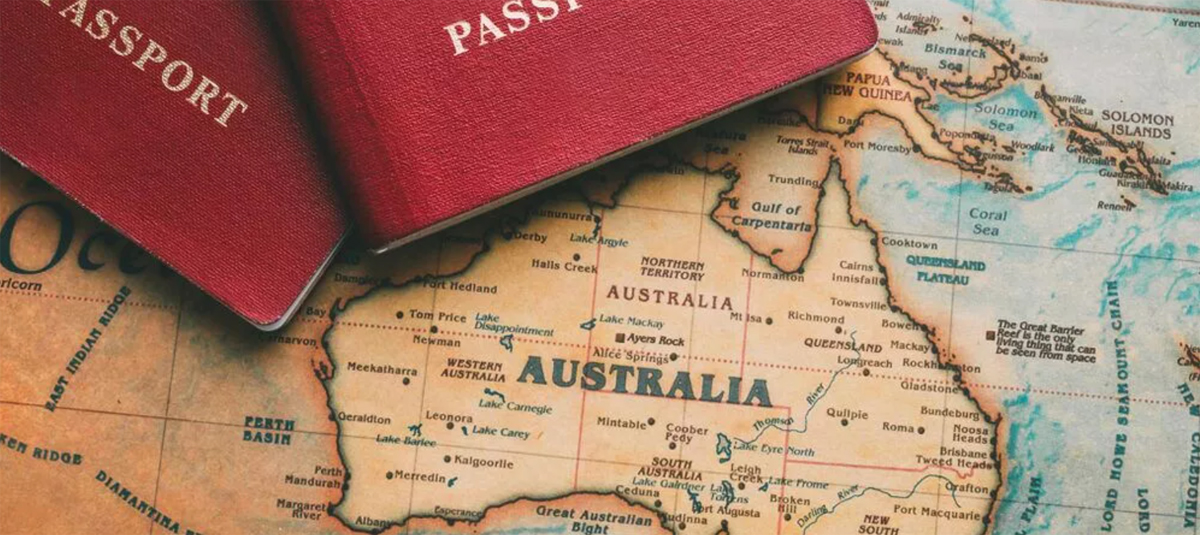 Minister for Home Affairs Clare O’Neil will implement a sweeping overhaul, providing 2.1 million temporary migrants with pathways to permanent residency.
Minister for Home Affairs Clare O’Neil will implement a sweeping overhaul, providing 2.1 million temporary migrants with pathways to permanent residency.
The government strategy includes key measures in the May 9 budget, with other major changes to the immigration system rolling out across the year.
Ms O’Neil recently announced the first increase to the Temporary Skilled Migration Income Threshold (TSMIT) in a decade, ordering a July 1 lift in the minimum rate paid by employers to temporary skilled shortage visa holders from $53,900 to $70,000.
As Australian employers fall behind in the race for global talent, the federal government has also committed to giving temporary skilled workers pathways to permanent residency by December.
The Home Affairs Department will also lead an aggressive push to retain more highly skilled international students and weed out foreigners using tertiary education as a backdoor for work, as new data shows only 33 per cent of graduates are working in jobs equal to their skill levels.

According to a report by Western Union, 67 per cent of migrants state that being able to send money to family was a key factor in their decision to move to Australia.
Just over half (51 per cent) of migrants living in Australia believe their friends or family would be in poverty if it wasn’t for them sending regular payments back home, a new report shows.
The Western Union report – The Value of Remittance – looks to shed light on the real-world impact of remittance payments. It found 57 per cent of migrants believe that without being able to send money, their family or friends would not be able to afford medical treatment. Fifty-six per cent state they would not be able to afford good quality food.
Fifty-three per cent went on to say their family would not be able to attend school or further education if it wasn’t for the remittance that they send. Fifty-one per cent stated they wouldn’t be able to afford their rent or mortgage.
The study, which surveyed 1,500 migrants living in Australia, shows the positive effect remittance payments have on families around the world. The report found 79 per cent of migrants believe their family’s quality of life has improved vastly due to the money that they send, and 77 per cent believe their family and friends have more opportunities in life as a result of their remittance payments.
How is remittance being used by families of migrants living in Australia?
On average, migrants were found to send 11 per cent of their annual income as remittance. The primary reasons for sending remittance included contributing towards their family’s food bill (67 per cent), healthcare costs (60 per cent) and accommodation (42 per cent).
Ninety-two per cent of migrants said they had sent money to family back home in the past 12 months and 67 per cent of migrants stated that being able to send money to family back home was a key factor in their decision to move to Australia.

Hobart has been crowned the best city in Australia, New Zealand and the South Pacific!
With the best sights, landmarks, food and friendly people, Travel + Leisure magazine readers placed Hobart as the #1 city to visit.
Acting Hobart Lord Mayor Helen Burnet said the recognition from such a respected travel publication is a “great accolade” for city.
“It is a massive achievement and testament to just how far Hobart has come in developing experiences, attractions and events that are unique, distinct and genuinely world class,” Cr Burnet said.
“Hobart is home to the most visited tourism attraction in the state, Salamanca Market, which saw over 450,000 visitors between April 2022 and March 2023.”
“Kunanyi/Mt Wellington is the second most popular tourist attraction, and the most popular natural attraction.”
An estimated 390,000 visitors a year, excluding locals, visit the mountain with around 65% of visitors coming from interstate or international destinations.
City Economy Portfolio Chair Alderman Louise Bloomfield said Hobart well and truly has what the rest of the world wants.
“Ever since 2015, when Lonely Planet rated Tasmania as one of the top ten destinations in the world, tourist numbers have boomed on the island,” Cr Bloomfield said.
“Hobart is at the centre of what makes Tasmania special and is a thriving home for the best that our island has to offer. It is no wonder we have been recognised.”
A quick hour-long flight from Melbourne, the magazine say the city offers an experience all its own.
“A typical day for travelers might look like a morning swim at a beach just outside of the city, coffee at a locally owned cafe in the center, an afternoon hike on a nearby mountain trail, and back to town for oysters and wine on the waterfront.”
“For a city with a population of just over 200,000, there’s a lot to see and do.”
Queenstown and Wellington NZ also made the list, alongside Sydney and Melbourne.

The much-awaited, extended two-year visa stay is now available for many eligible international Temporary Graduate visa holders in areas of verified skills shortages. The government recently released a list of over 3,200 courses eligible for the 485 visa extensions.
KEY POINTS
A migration legislative instrument, issued by the Department of Home Affairs, confirms that international higher education graduates with eligible qualifications will be granted an additional two years of work rights after graduation beginning July 1, 2023.
Temporary Graduate visa holders (subclass 485) who are holding visa in post study stream as of 1 July 2023 or students who will be lodging visas under the post study stream on and after 1 July 2023 and who are ‘eligible graduates’ can apply this visa.
The primary qualifications are across health care, medicine, engineering and information technology and will be reviewed annually. With an expanded range of eligible courses, more individuals can pursue their career aspirations while enjoying an extended stay in Australia.
This extension is for the ‘eligible graduates’ whose CRICOS Code and qualifications are there on the list published by the Department of Home Affairs.
For the selected bachelor degrees, the visa stay period will be extended from two years to four years.
Graduates in the selected master’s degree courses will enjoy a longer visa stay of five years, as opposed to the previous three years, and the extension for individuals with doctoral degrees will be from four to six years.
To be eligible for this, applicants must meet the relevant criteria. If approved, the visa will grant an additional two years of stay in Australia, starting from the original expiration date of the applicant’s current visa at no extra cost.
How to apply for the extension?
Applicants who studied an eligible qualification in the post-study work stream will need to make a new application.
There are no automatic extensions going to happen, you need to apply to get the additional two (or more) years.
Right now, there is no visa fee, no English language test, or police check requirements.
Nirlep Singh, a temporary graduate from Melbourne, says that his course is listed in the legislative instrument. Still, the online portal is warning him about his eligibility, regardless of being eligible according to the criteria given.
“Even though my degree and (tertiary) institute are on the list, I have received an error message warning me that I may not be eligible,” he sais.
Many applicants have encountered this similar warning in the past few days while applying.
It’s a casual warning to confirm and review the eligibility criteria. It says ‘you may not be eligible’ but lets you continue the application.
You can find the released list of the courses to receive extended, post-study work rights here.
When announcing this decision, previously, Minister for Education, Jason Clare, stated that he would like to see more international students stay in Australia after graduation rather than just studying in Australia and working in retail or hospitality.
Earlier in April, in a significant shake-up to repair the Australian immigration system, the Albanese Government released a slew of reforms to protect the interests of skilled migrants, international students and families.
Disclaimer: This article is for general information only. For specific visa advice, people are urged to check with the Department of Home Affairs.

Unprecedented demand from students is supercharging a resurgent international education market, bringing some relief to city cafes and restaurants desperate for casual staff.
For the first time, applications from Indian students far outnumber those from other countries, including China, and a new enthusiasm for more expensive Group of Eight universities is resulting in double-digit growth.
After a three-year hiatus due to COVID-19, universities are expecting to return to pre-pandemic levels, with new enrolments for this year making up for diminished numbers since 2020.
Students continue to arrive early in large numbers.
“We are seeing a very robust rebound of international students in NSW, and indeed across Australia,” said Professor Barney Glover, chairman of the NSW Vice Chancellors’ Committee and vice chancellor of Western Sydney University.
“In particular, there is a strong response from South Asian countries, including India, Pakistan, Nepal, Bangladesh and Sri Lanka.”
While Indians are leading the charge, universities are reporting big increases in enrolments from countries such as Singapore, Hong Kong, South Korea, Vietnam, Indonesia and Thailand.
The thaw in Chinese trade relations and the opening of borders coincides with the start of the academic year. Visa applications are up by 40 per cent on 2019, which was the biggest year on record.
Difficulty finding staff
International education is among Australia’s biggest export earners but had slipped back to $22.5 billion in 2021, down from $31.7 billion in 2020 and $40.3 billion in 2019.
Experts say Australia’s newfound popularity, particularly from India, may be a result of visa issues in Britain, heavy discounting of fees last year, a low Australian dollar, a healthy jobs market and perceptions of Australia as a safe country to live in.
Cafe manager Rafaella Caldez, who runs Stock Market Kitchen in Sydney, said half of the cafe’s new and prospective employees were international students, and the other half were people on tourist visas.
“It will be a lot easier [to hire staff] because I can see lots of students overseas and holiday visa workers are arriving already,” Ms Caldez said.
Before January, Ms Caldez said finding staff was difficult despite a boost in customers as workers returned to the office. Many of Stock Market Kitchen’s staff had left Australia during lockdowns, she said.
At Single O cafe in Sydney’s Surry Hills, staffing numbers had also increased, general manager Mike Brabant said, largely due to international hires re-emerging from September onwards and former hospitality workers returning to the industry.
“With more people coming into Australia, particularly around the cities, that’s a positive,” Mr Brabant said.
He said international workers were mainly flocking to cities, however, and Single O was still struggling to attract regional workers.
“That’s the gap we’re seeing at the moment. If I look at my wholesale networks, there’s still challenges in the regions,” Mr Brabant said.
Professor Michael Wesley, deputy vice chancellor (international) at the University of Melbourne, said the university had put a lot of focus on the Indian market, which explained, in part, the surge in interest, but he also pointed to friendly relations between the governments of Anthony Albanese and Narendra Modi.
“Bilateral relations have improved so remarkably that it is helping put Australia on the map a little bit more,” Professor Wesley said.
“It is making Australia more prominent in the Indian national conscience.”
After three pandemic-affected years, Professor Wesley said he was delighted to see the inner-city streets in Parkville and Carlton bustling as students returned to Australia.

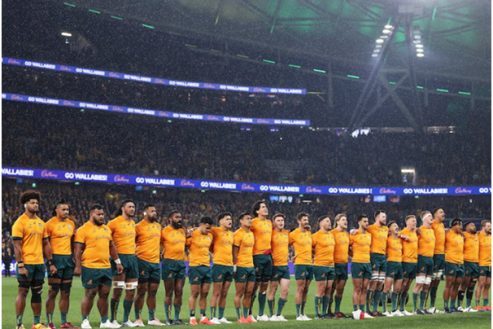




Australia’s newest major winter event ‘Illuminate Adelaide’ was a beacon of invitation, a city-wide spectacle of art, light, sound, and imagination, daring city goers to shake off the winter blues and rekindle a sense of wonder! Adelaide, South Australia. July 2023



A cute koala spotted having his daily long snooze! Blue Mountains, NSW. July 2023
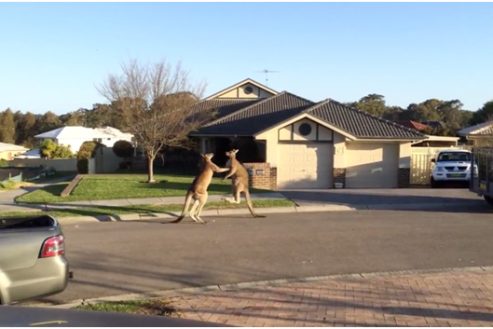
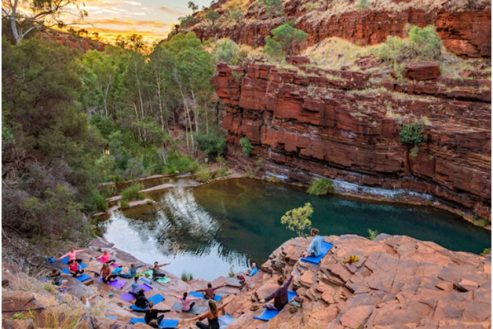
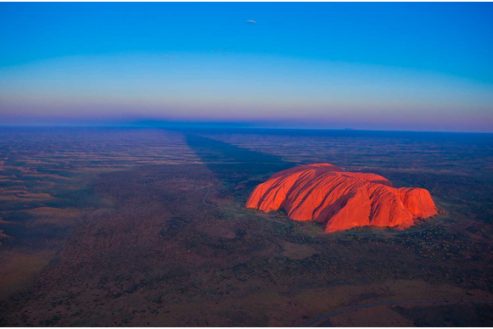
This Bulletin and its contents is for general information purposes only and should not be used as a substitute for consultation with professional advisors.
As legislation and travel requirements are constantly changing, we strongly recommend obtaining advice on your individual situation from a Registered Migration Agent. Please click here to book a consultation with one of our Registered Australian Migration Agents, located in Australia.






You can manage your membership and billing method by clicking here
Terms of Service
Privacy Policy
Copyright © 2025 Office of Immigration Australia, a private company registered in Australia. All Rights Reserved.